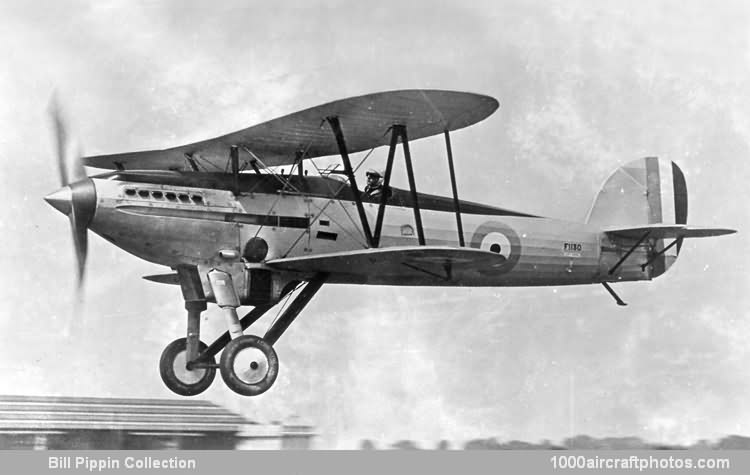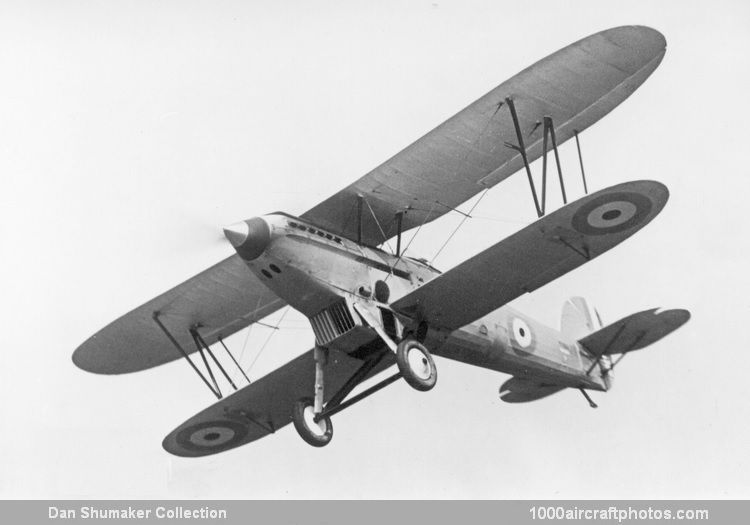04/30/2014. Remarks by
Johan Visschedijk: "By 1927 the British Air Ministry had become concerned about the increasing prospective capabilities of bomber forces and had issued specification F.20/27 for a fast-climbing single-seat interceptor fighter which would, by virtue of its high-altitude performance, do away with the earlier concept of defense by airborne patrol.
Initially, the specification called for the use of the then Ministry-favored radial type of engine and several manufacturers had built prototypes to meet this requirement before the Ministry recognized that the liquid-cooled in-line engine was essential for the required performance. In 1928 the specification was amended to require the use of the Rolls-Royce F.XI twelve-cylinder liquid-cooled V-engine.
(
Dan Shumaker Collection)
To meet this specification, the Firefly II (c/n F.1130) was designed and built with a composite, partly metal, structure. This was flown for the first time by Chief Test Pilot Norman Macmillan from Northolt on February 5, 1929. Later, the aircraft was considerably modified as the Mk.IIM (signifying metal construction), and was flown initially, again by Macmillan, from Northolt on January 6, 1930.
Both in its Mk.II and the Mk.IIM forms, the new Firefly was very unlike its Mk.I namesake – not only in structure, specifically in the case of the Mk.IIM, but also in overall design. Both Mk.II versions had, for instance, heavily staggered wings with N-type interplane struts and were powered by the 480 hp F.XIS engine which was to be redesignated the Kestrel IIS during 1930. In addition to the basic structural changes, other modifications were made to F.1130 during its metamorphosis. A retractable radiator and interconnected surface-cooling system was changed for a fixed underslung radiator between the landing gear legs.
The landing gear, tail, fuselage, wings and interplane struts were also modified, and struts replaced wires for the interconnection of the pairs of high-aspect-ratio ailerons. Descriptions at the time suggest that this modification was related to the fitting of camber-changing gear. The aileron controls were arranged for maximum leverage when not used as flaps and with increased travel and differential action as they were lowered by means of a crank on .the starboard side of the cockpit.
This camber-changing gear does not appear to have been fitted to the production version. Fuel tankage was 62.5 gal (237 l): 48 gal (182 l) in the main and 14.5 gal (55 l) in the gravity tank. An interesting comment in that era of open cockpits was one made in Flight to the effect that hot air, tapped from the radiator, made the pilot's environment sufficiently comfortable for 'writing with bare hands' to be possible at 21,000 ft (6,400 m) with an outside air temperature of minus 29° F (minus 34° deg C).
In its original Mk.II form this very competent-looking fighter was beaten, during the 1929 interceptor 'competition' at the
A&AEE Martlesham, by the Hawker Hornet which, as the developed Fury, was ordered for the RAF in 1930.
As with the first Fairey Fox, something of a legend has been built around the Firefly Mk.II, with its sale to the Belgian AF and the later formation of Avions Fairey for the assembly of Fox Mk.II and derivatives, and of Firefly Mk.IIMs in Belgium. The revised prototype was demonstrated among the new types at the RAF Display at Hendon in June 1930 and aroused considerable interest among overseas visitors because, having failed in competition with the Fury, it was thus available for sale abroad.
The story goes that a chance remark at the display by a member of a Belgian mission gave the Fairey directors the idea of sending the prototype to be demonstrated in Belgium, where a still-indecisive competition was being held at Evère, near Brussels, for the selection of a new fighter for the Belgian Air Force. The Firefly Mk.IIM, civil-registered G-ABCN on July 7, 1930, was duly flown over to Belgium on July 23, by Flight Lieutenant C.S. Staniland and was demonstrated with considerable effect in competition with the Czechoslovakian
Avia BH.33 and the French
Dewoitine D.27.
More important, perhaps, was the fact that Staniland and the Fairey representatives showed their confidence in the aircraft by permitting it to be flown in turn by sixteen Belgian fighter pilots at Evère, Schaffen and Nivelles. The culminating trial involved a demonstration, using recording gear, of a powered dive to what was later known as its 'terminal velocity'. The well-documented story has it that the Firefly was the only aircraft whose pilot and sponsors agreed to make this test and that a successful completion led to its adoption, 87 aircraft being ordered for the Belgian AF.
The first 25 were built at Hayes, UK, and the first five
Firefly Mk.IIs were delivered to Belgium on July 10, 1931. Formed on September 12, 1931, the Belgian company Société Anonyme Belge Avions Fairey at Gosselies, near Charleroi, Belgium, built the remaining 62 aircraft for the Belgian AF, the first was delivered on February 26, 1932.
Avions Fairey built one additional 88th Firefly Mk.II which was sold to the USSR in 1932 for evaluation. It was demonstrated by Fairey pilot S.H.G. Trower at Khodynka, Moscow, on November 2, but no orders followed. The pictured prototype was deregistered as "permanently withdrawn from use" in December 1932."

